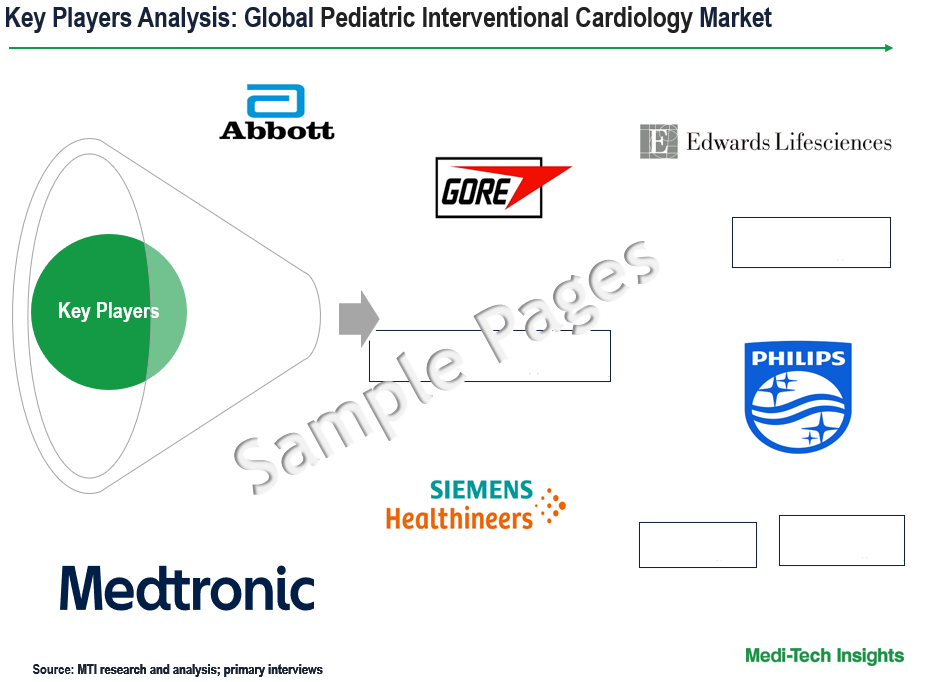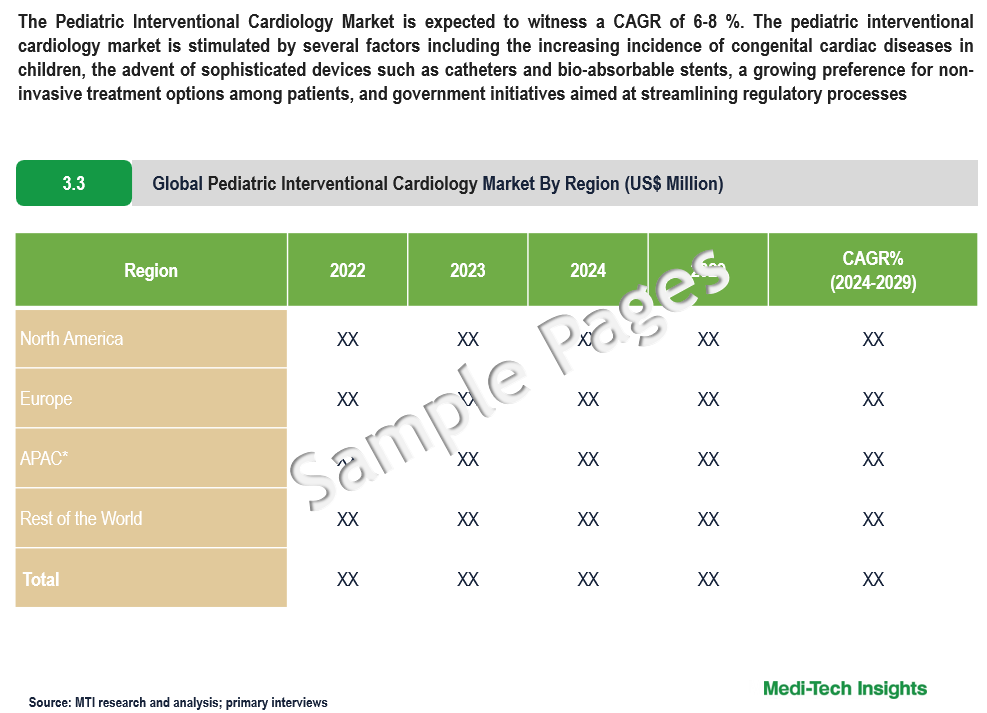
Pediatric Interventional Cardiology Market Size, Trends, Growth Analysis, Industry Share and Forecast to 2029
The Pediatric Interventional Cardiology Market is expected to witness a CAGR of 6-8 %. The pediatric interventional cardiology market is stimulated by several factors including the increasing incidence of congenital cardiac diseases in children, the advent of sophisticated devices such as catheters and bio-absorbable stents, a growing preference for non-invasive treatment options among patients, and government initiatives aimed at streamlining regulatory processes. Moreover, significant investments in research and development, escalating healthcare expenditure, and ongoing technological advancements in cardiology further propel market expansion. To learn more about the research report, download a sample report.
Pediatric interventional cardiology is a specialized medical field dedicated to diagnosing and treating congenital heart defects and other cardiovascular issues in infants, children, and adolescents. It combines aspects of pediatric cardiology, which focuses on pediatric heart conditions, with interventional cardiology, utilizing minimally invasive procedures like catheterization to diagnose and treat heart problems. By inserting catheters through blood vessels, usually in the groin, and guiding them to the heart, this approach minimizes recovery times, reduces complications, and lessens patient discomfort compared to traditional open-heart surgery. Common procedures include balloon angioplasty to widen narrowed blood vessels, stent placement to keep vessels open, closure of septal defects with devices like mesh patches, and coil embolization to block abnormal vessels. Overall, pediatric interventional cardiology significantly improves the quality of life and long-term outcomes for children with heart conditions by offering effective and minimally invasive treatments.
Transforming Pediatric Cardiology: Innovations in Minimally Invasive Techniques and Imaging Technologies
Within pediatric interventional cardiology, there is a growing adoption of minimally invasive techniques, such as catheter-based interventions, to address congenital heart defects, valve disorders, and other cardiovascular conditions in children. These approaches not only reduce reliance on open-heart surgery but also facilitate quicker recovery periods. Moreover, advancements in imaging technologies, including 3D echocardiography, cardiac MRI, and CT angiography, are pivotal in guiding interventions and refining patient outcomes by offering detailed anatomical insights for precise diagnosis and treatment planning. With the evolution of technology and expertise, there's a discernible trend towards tackling more complex interventions, such as transcatheter valve implantation and closure of intricate defects, often through hybrid approaches that combine surgical and catheter-based techniques. The growing adoption of transcatheter valve therapies, such as transcatheter aortic valve replacement (TAVR) and pulmonary valve replacement (TPVR), underscores the shift towards less invasive alternatives with promising outcomes and reduced procedural risks. Furthermore, ongoing research endeavours and collaborative initiatives persistently drive innovation in pediatric interventional cardiology, aiming to refine procedural techniques, develop novel treatments, and optimize patient care standards. For instance,
- In January 2024, Philips announced that its new TEE transducer, the X11-4t Mini 3D, has obtained FDA 510(k) clearance, offering enhanced comfort and potential anaesthesia reduction during minimally invasive procedures. Philips has developed this smaller transducer to expand accessibility to valuable imaging for patients of all ages, ranging from pediatric to geriatric populations.

To learn more about this report, download the PDF brochure
Advancing Pediatric Cardiac Care: Integrating Technology and Personalized Medicine
The landscape of pediatric interventional cardiology is poised for transformative advancements in device technology that are anticipated to broaden the range of interventions available for pediatric patients. This includes the development of smaller, more flexible devices suitable for use in infants and neonates, as well as the exploration of bioresorbable and tissue-engineered constructs for repairing heart defects. Moreover, there is a growing emphasis on personalized medicine within the field, with treatment strategies tailored to individual patient characteristics, aiming to optimize outcomes and minimize complications. Integration of robotics and artificial intelligence (AI) holds immense potential to revolutionize pediatric interventional cardiology by enhancing procedural precision, reducing radiation exposure, and improving patient safety. AI algorithms may also play a significant role in image analysis, treatment planning, and outcome prediction Additionally, manufacturers are focusing on developing specialized devices and equipment specifically designed for pediatric patients, including smaller catheters, delivery systems, and occlusion devices. The adoption of telemedicine and remote monitoring technologies is facilitating access to specialized pediatric cardiology care, particularly in underserved areas, through remote consultations, virtual follow-ups, and remote monitoring of implanted devices. These technological innovations will expand treatment options, enhance procedural precision, and improve patient outcomes, while also increasing accessibility to specialized care.
Key Constraints/Challenges
Pediatric interventional cardiology, while offering significant advancements in treating congenital heart defects and other cardiovascular conditions in children, also faces several other challenges. High procedure costs often surpass reimbursement rates, especially for novel interventions, posing financial barriers. Additionally, the limited availability of pediatric-specific devices approved for use and a shortage of skilled professionals impede market growth and the provision of comprehensive care. Addressing these challenges necessitates efforts to improve reimbursement policies, and expand device options tailored for pediatric use to meet the specialized needs of pediatric interventional cardiology.
Regional Dynamics of the Pediatric Interventional Cardiology Market
The global landscape of pediatric interventional cardiology demonstrates diverse regional dynamics, each contributing to market growth in unique ways. North America leads the pediatric interventional cardiology field, supported by its advanced healthcare infrastructure, technological advancements, and substantial healthcare investments. The United States, in particular, dominates the market due to its sizable patient population, well-established medical facilities, and significant research and development funding. Meanwhile, Europe holds a significant position in the pediatric interventional cardiology market, driven by factors like increasing healthcare spending, adoption of advanced medical technologies, and favorable governmental policies. The Asia Pacific region is experiencing rapid growth in pediatric interventional cardiology, propelled by factors such as rising healthcare awareness, improving healthcare infrastructure, and increasing prevalence of congenital heart diseases. Key countries such as China, India, and Japan are emerging as prominent players in this market, fueled by their large pediatric populations and growing demand for specialized medical interventions. In conclusion, regional variations in healthcare infrastructure, technological adoption, and disease prevalence shape the pediatric interventional cardiology market, highlighting the importance of tailored strategies for success across different geographical regions.
Competitive Landscape
Major players in the pediatric interventional cardiology market are Abbott, W.L. Gore & Associates, Inc., Boston Scientific Corporation, Edward Lifesciences Corporation, Siemens, NuMed, Inc., B. Braun Melsungen AG, Cardinal Health, Medtronic, Agilent Technologies, Inc., Koninklijke Philips N.V., Terumo Medical Corporation, and F. Hoffmann-La Roche Ltd., among others.

Get a sample report for competitive landscape analysis
Organic and Inorganic Growth Strategies Adopted by Players to Establish Their Foothold in the Market
Players operating in this market are adopting both organic and inorganic growth strategies such as collaborations, and acquisitions to garner market share. For instance,
- In December 2021, Edwards Lifesciences received FDA approval for the use of the Edwards SAPIEN 3 transcatheter valve in conjunction with the Alterra adaptive prestent (SAPIEN 3 with Alterra), catering to patients with severe pulmonary regurgitation. This innovative system combines the SAPIEN 3 transcatheter heart valve with the Alterra prestent, offering expanded therapeutic options for individuals with congenital heart valve disease. The Alterra prestent addresses variations in the right ventricular outflow tract, ensuring a stable landing zone for the SAPIEN 3 valve and enhancing treatment efficacy
- In June 2021, Abbott introduced the Amplatzer Piccolo™ Occluder, the world's first medical device designed for implantation in infants as small as 700 grams through a minimally invasive procedure, providing a breakthrough treatment option for patent ductus arteriosus (PDA) in premature newborns at risk for corrective surgery and unresponsive to medication.
The pediatric interventional cardiology market is expected to gain momentum in the coming years due to the growing prevalence of cardiovascular diseases, rising demand for minimally invasive treatments, technological advancements, strategic collaborations and aggressive organic and inorganic growth strategies followed by the players.
Key Strategic Questions Addressed
-
What is the market size & forecast for the Global Pediatric Interventional Cardiology Market?
-
What are the historical, present, and forecasted market shares and growth rates of various segments and sub-segments of the Global Pediatric Interventional Cardiology Market?
-
How has COVID-19 impacted the Global Pediatric Interventional Cardiology Market?
-
What are the major growth drivers, restraints/challenges impacting the market?
-
What are the opportunities prevailing in the market?
-
What is the investment landscape?
-
Which region has the highest share in the global market? Which region is expected to witness the highest growth rate in the next 5 years?
-
Who are the major players operating in the market? What is the competitive positioning of key players?
-
Who are the new players entering the market?
-
What are the key strategies adopted by players?
- Research Methodology
- Secondary Research
- Primary Research
- Market Estimation
- Market Forecasting
- Executive Summary
- Market Overview
- Market Dynamics
- Drivers
- Restraints
- Opportunities
- Market Dynamics
- Global Pediatric Interventional Cardiology Market - Size & Forecast (2021-2028), By Device Type
- Catheters
- Ballons
- Stents
- Other Devices
- Global Pediatric Interventional Cardiology Market - Size & Forecast (2021-2028), By Procedure Type
- Catheter-Based Valve Implantation
- Congenital Heart Defect Correction
- Angioplasty
- Other Procedures
- Global Pediatric Interventional Cardiology Market - Size & Forecast (2021-2028), By End User
- Hospitals
- Pediatric Clinics
- Academic & Research Institutes
- Other End Users
- Global Pediatric Interventional Cardiology Market - Size & Forecast (2021-2028), By Region
- North America (U.S. & Canada)
- Europe (UK, Germany, France, Italy, Spain, Rest of Europe)
- Asia Pacific (China, India, Japan, Rest of Asia Pacific)
- Rest of the World (Latin America, Middle East & Africa)
- Competitive Landscape
- Key Players and their Competitive Positioning
- Competitive Positioning of Key Players (2022)
- Offerings Assessment, By Players
- Key Strategies Assessment, By Player (2021-2023)
- New Product Launches
- Partnerships, Agreements, & Collaborations
- Mergers & Acquisitions
- Other Developments
- Key Players and their Competitive Positioning
- Key Companies Scanned (Indicative List)
- Abbott
- L. Gore & Associates, Inc.
- Boston Scientific Corporation
- Edward Lifesciences Corporation
- Siemens
- NuMed, Inc.
- Braun Melsungen AG
- Cardinal Health
- Medtronic
- Agilent Technologies, Inc.
- Koninklijke Philips N.V.
- Hoffmann-La Roche Ltd.
- Other Players
The study has been compiled based on extensive primary and secondary research.
Secondary Research (Indicative List)

Primary Research
To validate research findings (market size & forecasts, market segmentation, market dynamics, competitive landscape, key industry trends, etc.), extensive primary interviews were conducted with both supply and demand-side stakeholders.
Supply Side Stakeholders:
- Senior Management Level: CEOs, Presidents, Vice-Presidents, Directors, Chief Technology Officers, Chief Commercial Officers
- Mid-Management Level: Product Managers, Sales Managers, Brand Managers, Business Development Managers, Consultants
Demand Side Stakeholders:
- Stakeholders in Hospitals, Clinical Testing Laboratories, Pediatric Clinics and Academic & Research Institutes among others
Breakdown of Primary Interviews

Market Size Estimation
Both ‘Top-Down and Bottom-Up Approaches’ were used to derive market size estimates and forecasts.
Data Triangulation
Research findings derived through secondary sources & internal analysis were validated with Primary Interviews, Internal Knowledge Repository, and Company Sales Data.


